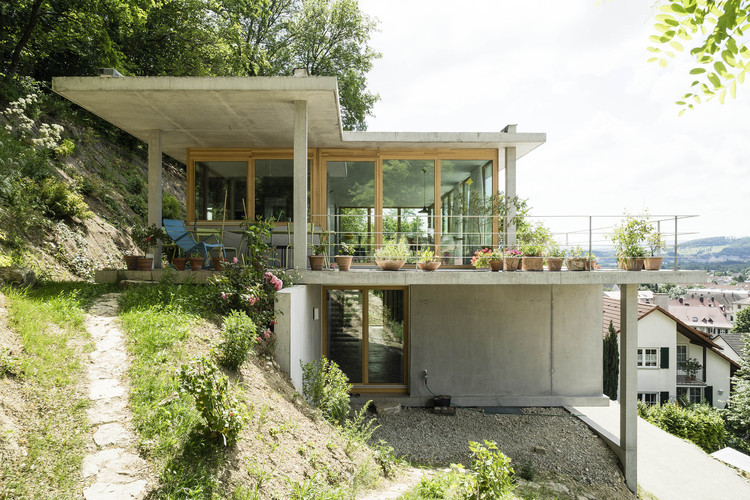Best Way to Build a House on a Slope
House on a Gradient / Gian Salis Builder





 + 20
+ 20
- Year : 2013

"Each function of the construction should take its own beauty and power. The house was designed as if the Structural piece of work would accept existed for some fourth dimension and the Interior outfitting come up only now. The thereby arose 'in between rooms' give the house its openness."

The building site is overgrown with natural wooded undergrowth on a steeply inclined hillside with a wide prospect over the flat valley of the River Rhine equally far equally Basle. In earlier times grapevines were cultivated on the sun-facing hillside. The client'southward wish is for an affordable house with small rooms, only which nevertheless collaborate with the unspoiled countryside via large windows.

Based on this topography, 2 terracing walls – that simultaneously create a tamed territory – form the basic construction of the house, and anchor it in the hillside. The lower wall creates a courtyard in front of the house. A large opening in it leads to the garage and the workshop. Following line of the hillside around the terracing walls i comes to the upper entrance and bedroom storey. At this point the second terracing wall creates a space for the entrance area, leading into the business firm beneath the cantilevered roof and creating a line of sight out through the other side back out into the countryside. This wall runs through the unabridged firm, constituting its backbone. Ancillary rooms such as the wardrobe and irresolute room are bundled behind the untreated exposed-physical wall on the hillside. Bedrooms and the bathroom are bundled out towards the valley, separated past low-cal pine-chipboard walls. Physical steps inserted into the wall lead up to the open up-plan living and dining room to a higher place. A terrace juts out in front end of this storey, whilst the same wall forms the back that stabilises the open-program space. Two big openings lead through to the rear spatial layer with the kitchen and ancillary rooms, making the hillside backside the house tangible.
.jpg?1440806689)

.jpg?1440806710)
The varying projections of the storey ceilings grade terraces and protruding roofs, creating specific exterior spaces as counterparts to each interior infinite. This issue molds the character of the interior spaces via the big windows. For instance the rooms facing the hillside and the undergrowth are shaded, absurd and somewhat introverted, while the counterpoised rooms facing the valley nigh get loggias when the windows are opened. Linen defunction and horizontal slat blinds let the caste of light permeability to be controlled. The large protruding roofs foreclose an over-exposure to sunlight in summer, whilst in wintertime the low-lying sun warms the oestrus-retentive concrete.

The structural walls and roofs are fabricated of untreated exposed physical. In those places were the rooms are attached, the exterior concrete walls are treated with mineral insulation and rendered with a smoothen dirt plaster. This insulating layer is externally legible at the framework widenings of the oiled pinewood window frames. The interior walls remain in exposed concrete, whilst the floors are likewise in exposed cement screed. Non-load-begetting walls, doors and cupboards are made of cheap pine chipboard. The railings are composed of sparse, rolled stainless-steel sections welded together. Equally far as possible all of the materials are used in their raw states, and are intended to assume their natural patina over fourth dimension. The construction details are formed directly and naturally, whereby simple shadow gaps separate the various building elements giving them an autonomous appearance. In contrast the dimensioning and proportioning of the building elements are dictated by lightness and subtleness in lodge to lend the building a certain air of nobility.

Project gallery
See all Show less
About this office
![]()
Cite: "House on a Slope / Gian Salis Architect" 16 Mar 2019. ArchDaily. Accessed . <https://www.archdaily.com/772720/business firm-on-a-gradient-gian-salis-architect> ISSN 0719-8884
世界上最受欢迎的建筑网站现已推出你的母语版本!
想浏览ArchDaily中国吗?
是否
Did you know?
Y'all'll at present receive updates based on what you lot follow! Personalize your stream and showtime following your favorite authors, offices and users.
montgomeryyoucity.blogspot.com
Source: https://www.archdaily.com/772720/house-on-a-slope-gian-salis-architect
Post a Comment for "Best Way to Build a House on a Slope"